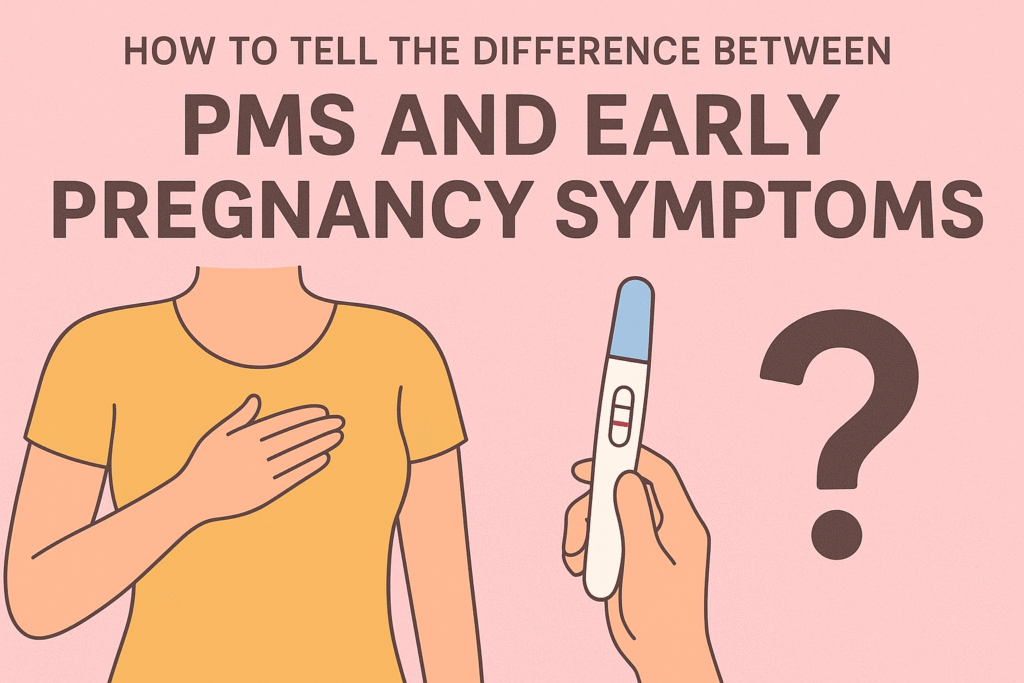
⚠️ Affiliate Disclaimer: This post may contain affiliate links, which means I may earn a small commission — at no extra cost to you — if you make a purchase through one of these links. I only recommend products or services I genuinely trust and believe can provide value. Thank you for supporting My Medical Muse!
10 Powerful Differences Between PMS and Early Pregnancy Symptoms
How to Tell the Difference Between PMS and Early Pregnancy Symptoms
For many women, the days leading up to a period can feel like an emotional rollercoaster and a physical guessing game. You may notice breast tenderness, bloating, fatigue, mood swings, or even unusual food cravings, but here’s the dilemma, are these symptoms simply signs of premenstrual syndrome (PMS), or could they actually be early pregnancy symptoms?
The overlap between PMS and early pregnancy can be confusing, especially for women actively trying to conceive or those anxiously monitoring their menstrual cycles. Both conditions are driven by hormonal fluctuations and can look and feel remarkably similar. This often leaves women second-guessing their bodies until a period arrives or doesn’t.
Being able to distinguish between PMS and early pregnancy is not just about satisfying curiosity. It’s about peace of mind, reducing anxiety, and ensuring timely decisions, whether that means buying a pregnancy test, preparing for a period, or scheduling a doctor’s appointment.
In this comprehensive guide, we’ll carefully break down the differences, similarities, and subtle clues between PMS and early pregnancy. By the end, you’ll feel more confident interpreting your body’s signals and knowing when to take the next step.
Understanding PMS and Early Pregnancy
What is PMS?
Premenstrual Syndrome (PMS) is a common condition that affects up to 75% of menstruating women at some point in their lives. It refers to a combination of physical, emotional, and behavioral symptoms that occur in the luteal phase of the menstrual cycle, which is typically 7-14 days before menstruation begins.
Hormonal fluctuations, particularly in estrogen and progesterone are the primary triggers of PMS. These shifts influence neurotransmitters like serotonin, which explains the mood changes often associated with PMS.
Typical PMS symptoms include:
- Breast tenderness or swelling
- Bloating and water retention
- Mood swings, irritability, or anxiety
- Headaches or back pain
- Fatigue and difficulty sleeping
- Cravings for carbohydrates or sweets
Importantly, PMS symptoms usually resolve once menstruation begins, offering a predictable pattern for many women.
What is Early Pregnancy?
Early pregnancy refers to the very first weeks following conception, often before a woman realizes she is pregnant. This stage begins when a fertilized egg implants into the uterine lining, prompting the body to start producing human chorionic gonadotropin (hCG) along with higher levels of progesterone and estrogen.
These hormonal changes create a cascade of physical and emotional shifts as the body begins supporting a developing embryo.
Common early pregnancy symptoms include:
- Persistent breast soreness and changes in areola color
- Fatigue that doesn’t improve with rest
- Nausea or “morning sickness,” sometimes beginning as early as 2-4 weeks
- Frequent urination
- Food aversions or unusual cravings
- Light spotting (implantation bleeding)
- Missed period, the most obvious sign
Unlike PMS, early pregnancy symptoms tend to persist and intensify as hormone levels rise.
Why the Confusion?
It’s no surprise that PMS and early pregnancy are often mistaken for one another. Both conditions involve rising progesterone levels, which affect the body in remarkably similar ways. For example:
- Breast changes occur in both PMS and pregnancy, but with different durations.
- Cramps and bloating can appear before menstruation or in early pregnancy.
- Mood changes and fatigue are hallmark signs of both conditions.
Because of this overlap, many women are left guessing until either menstruation begins or a pregnancy test confirms the truth. This is particularly stressful for those trying to conceive, as every twinge or craving may feel like a potential pregnancy symptom.
The good news is that while PMS and early pregnancy look alike on the surface, there are subtle differences in timing, intensity, and persistence. Understanding these nuances can provide valuable insight into what your body is truly experiencing.
Symptom-by-Symptom Comparison
1. Breast Changes
PMS:
Breast swelling, heaviness, or tenderness is one of the most common PMS symptoms. This happens because of cyclical changes in estrogen and progesterone, which cause fluid retention and stimulate breast tissue. The discomfort usually begins in the second half of the cycle and fades once your period starts.
Early Pregnancy:
In pregnancy, breast changes can feel similar but tend to persist and intensify rather than resolve. Many women notice a tingling or prickling sensation, increased fullness, and visible veins. The areolas may darken, and small bumps called Montgomery glands can become more pronounced. These changes begin as early as 1-2 weeks after conception.
If breast pain disappears once bleeding begins, it’s PMS. If it lingers and continues to worsen after a missed period, pregnancy is a strong possibility.
2. Bloating and Cramping
PMS:
Hormonal shifts trigger water retention and gas buildup, leading to uncomfortable bloating. Cramping usually starts just before menstruation or on the first day, caused by the uterus contracting to shed its lining. These cramps are often sharp and can range from mild to severe, usually improving after a few days.
Early Pregnancy:
Hormonal changes, especially progesterone, slow digestion, leading to bloating that feels similar to PMS. Cramping in early pregnancy is usually milder and may feel like a dull tugging or pulling sensation as the uterus expands. Unlike menstrual cramps, these are not accompanied by heavy bleeding.
Severe cramps with heavy flow point to PMS. Mild cramps without bleeding, especially if paired with other pregnancy symptoms, may signal conception.
3. Fatigue
PMS:
Low energy is common before menstruation, often linked to disrupted sleep, changes in serotonin, and fluctuations in estrogen and progesterone. The fatigue usually lifts once menstruation begins.
Early Pregnancy:
Pregnancy fatigue is different, it’s often described as overwhelming and relentless. Rising progesterone levels act as a natural sedative, while the body also works harder to support a developing embryo, increasing metabolic demands. Many women report feeling unusually exhausted even after adequate rest.
PMS fatigue tends to improve once the period arrives. Persistent exhaustion beyond your expected period date is more typical of pregnancy.
4. Mood Changes
PMS:
Emotional shifts, irritability, sadness, or anxiety are strongly tied to PMS. These mood swings often follow a predictable monthly pattern and peak in the days leading up to menstruation.
Early Pregnancy:
Mood changes in early pregnancy may feel different. Many women experience heightened sensitivity, frequent crying spells, or sudden emotional extremes. Others describe a sense of calm or detachment, which isn’t as typical with PMS.
Predictable monthly irritability suggests PMS. Unexpected or unusually intense emotions may point toward pregnancy.
5. Appetite and Food Cravings
PMS:
Hormonal changes during PMS often lead to cravings for salty, sweet, or carb-heavy comfort foods. Many women also feel hungrier than usual, especially in the days before bleeding starts.
Early Pregnancy:
Food cravings can be unusual, some women desire foods they never liked before. At the same time, food aversions often develop, especially to strong smells, coffee, or spicy dishes. In some cases, nausea reduces appetite altogether.
If cravings are for the usual pre-period comfort foods, it’s likely PMS. If you’re suddenly put off by foods or smells you once enjoyed, pregnancy could be the reason.
6. Nausea and Vomiting
PMS:
Feeling queasy before a period is rare. While digestive changes may occur, vomiting is almost never a PMS symptom.
Early Pregnancy:
Nausea commonly known as morning sickness is one of the hallmark signs of pregnancy. It typically begins between 2-8 weeks after conception, though it doesn’t only happen in the morning. Some women experience mild queasiness, while others struggle with persistent nausea and vomiting.
Persistent or worsening nausea, especially if paired with a missed period, is a strong pregnancy indicator.
7. Bleeding or Spotting
PMS:
Menstrual bleeding often starts light but quickly becomes heavier, lasting 3-7 days depending on the individual cycle.
Early Pregnancy:
Some women notice implantation bleeding, which occurs when a fertilized egg attaches to the uterine lining. It is typically very light, lasting 1-3 days, and may appear pink, brown, or rust-colored. It does not resemble a full menstrual flow and doesn’t soak pads or tampons.
If spotting turns into a normal flow, it’s PMS. If it remains very light and short, it may be implantation bleeding.
8. Cervical Mucus
PMS:
Cervical mucus before a period usually decreases, becoming thicker, cloudy, or even dry as progesterone levels drop.
Early Pregnancy:
Many women notice an increase in cervical mucus after conception. It may appear milky white (called leukorrhea) and remain consistent throughout early pregnancy due to high estrogen levels.
Increased or persistent discharge after ovulation may be an early pregnancy sign, especially if accompanied by other symptoms.
9. Frequency of Urination
PMS:
This is not typically associated with PMS.
Early Pregnancy:
In early pregnancy, the body produces more blood and fluids, which increases kidney activity. Progesterone also relaxes bladder muscles, making women feel the urge to urinate more frequently, often one of the first noticeable symptoms.
If you’re urinating more often without drinking extra fluids, pregnancy is more likely.
10. Missed Period
PMS:
By definition, PMS symptoms fade once menstruation begins. A period arriving on time rules out pregnancy in most cases.
Early Pregnancy:
A missed period is the most significant and reliable early sign of pregnancy. For women with regular cycles, even a few days of delay can be a reason to take a test.
If your period doesn’t arrive on schedule, consider testing regardless of other symptoms.
Key Differences at a Glance
Symptom | PMS | Early Pregnancy |
Breast tenderness | Improves once menstruation begins | Persists, areolas may darken, veins visible |
Cramping | Strong, with bleeding | Mild, without heavy bleeding |
Mood swings | Irritability, anxiety | Emotional extremes, sensitivity, crying |
Nausea | Rare | Common, especially mornings |
Food cravings | Salty, sweet, high-carb | Unusual cravings, strong aversions |
Fatigue | Improves with onset of period | Persistent and intense |
Vaginal discharge | Thicker, cloudy, often reduced | Milky, increased (leukorrhea) |
Urination | Normal | More frequent |
Bleeding | Heavy, lasting several days | Light spotting (implantation) |
Missed period | No | Yes |
When to Take a Pregnancy Test
One of the most reliable ways to know whether you’re pregnant is to take a home pregnancy test (HPT), but the timing of the test plays a huge role in accuracy.
- Best time: The most accurate time to test is about one week after a missed period. By then, levels of the pregnancy hormone human chorionic gonadotropin (hCG) are high enough to be detected with confidence.
- Early testing: Some highly sensitive tests claim to detect hCG 10-12 days after ovulation (before your period is due). However, results at this stage may not be reliable. A negative result doesn’t always mean you aren’t pregnant, it could simply mean your body hasn’t produced enough detectable hCG yet.
- Accuracy tip: For the best results, take the test first thing in the morning. Morning urine is usually more concentrated, making it easier for the test to pick up hCG.
If you’re unsure: Don’t panic if the result is unclear. Repeat the test in a few days, as hCG levels double approximately every 48-72 hours in early pregnancy. For a definitive answer, ask your doctor about a blood test, which can detect even very low levels of hCG.
Myths and Misconceptions
Because PMS and pregnancy symptoms overlap, it’s easy for myths to spread. Let’s clear up some of the most common misconceptions:
Myth 1: “Implantation bleeding is always heavy.”
False. Implantation bleeding, if it occurs, is usually very light, just spotting that lasts a day or two. If the bleeding is heavy enough to soak pads or tampons, it’s almost certainly a menstrual period, not implantation.
Myth 2: “If you have PMS symptoms, you can’t be pregnant.”
False. Many early pregnancy symptoms mimic PMS, breast tenderness, bloating, mood swings, and fatigue. In fact, some women only realize they’re pregnant when PMS-like symptoms don’t go away after their expected period.
Myth 3: “You can’t get pregnancy symptoms before a missed period.”
False. Some women notice subtle changes 1-2 weeks after conception, well before their period is due. While not everyone experiences this, early signs like breast tingling, mild cramping, or unusual fatigue can appear surprisingly soon.
When to See a Doctor
While most PMS and early pregnancy symptoms are harmless, there are times when medical advice is necessary. Seek medical attention if you experience:
- Persistent or severe pelvic pain: This may indicate something more serious, like ovarian cysts, fibroids, or even ectopic pregnancy.
- Heavy or unusual bleeding: Passing large clots or soaking pads every hour is not typical and needs medical review.
- Positive pregnancy test with unusual symptoms: Such as sharp abdominal pain, dizziness, or heavy bleeding, which could signal complications.
- No period for more than 2 months with repeated negative pregnancy tests: This may indicate hormonal imbalances, thyroid disorders, or other underlying health issues.
Prompt care ensures both safety and peace of mind.
Tips for Coping with the Wait
The two-week wait between ovulation and your period or the days after a missed period before a clear pregnancy result can feel emotionally draining. Here are some strategies to stay calm and balanced:
- Track your cycle: Use apps or journals to record symptoms, flow patterns, and ovulation dates. Over time, this helps you notice what’s “normal” for your body.
- Practice stress relief: Try yoga, deep breathing, meditation, or gentle walks. Stress can worsen PMS symptoms and sometimes delay your period.
- Stay balanced: Focus on nutritious meals, staying hydrated, and getting quality sleep. These habits support overall hormonal health.
- Avoid over-testing: Taking multiple pregnancy tests too soon often causes unnecessary worry. Wait until at least the first day of your missed period or even a few days later for the most reliable results.
- Lean on support: If the waiting game is emotionally tough, talk with a trusted friend, partner, or counselor. Sharing your feelings helps ease the anxiety of uncertainty.
FAQs
1. Can you have pregnancy-like symptoms but not be pregnant?
Yes. Hormonal fluctuations during PMS often mimic pregnancy symptoms such as breast tenderness, bloating, fatigue, or mood swings. Additionally, stress, illness, or changes in diet and lifestyle can produce similar effects. That’s why it’s common to feel “pregnant” even when you’re not. The only reliable way to confirm pregnancy is through a test.
2. How soon can you feel pregnancy symptoms?
Some women report changes as early as 1-2 weeks after conception, particularly breast soreness or mild fatigue. However, most women don’t notice clear symptoms until after a missed period, when hormone levels are high enough to trigger more obvious signs like nausea or frequent urination.
3. Is implantation bleeding the same as a period?
No. Implantation bleeding is typically:
- Light (just spotting, not heavy flow)
- Short (lasting 1-3 days)
- Different in color (pink or brown, not bright red)
A period, on the other hand, usually involves heavier bleeding that increases in flow and lasts several days.
4. Can stress delay a period and cause PMS-like symptoms?
Yes. Stress impacts the brain’s hypothalamus, which controls hormone regulation and menstrual cycles. High stress levels can delay or even stop ovulation, leading to a late period. At the same time, stress-related hormonal changes can cause PMS-like symptoms such as bloating, headaches, mood swings, or fatigue, making it even more confusing.
5. Do all women experience nausea in early pregnancy?
No. While 70-80% of women experience some form of nausea or vomiting during early pregnancy, not everyone does. Some women may never feel nauseous, while others may struggle with hyperemesis gravidarum (severe, persistent morning sickness). The absence of nausea does not rule out pregnancy.
Conclusion
Distinguishing between PMS and early pregnancy symptoms can be challenging because the two conditions share so many similarities. The key differences often come down to timing, intensity, and persistence:
- PMS symptoms usually resolve once your period begins, following a predictable monthly pattern.
- Early pregnancy symptoms tend to linger and intensify, often accompanied by subtle but unique changes such as nausea, food aversions, or frequent urination.
Ultimately, the most reliable indicator remains a missed period followed by a positive pregnancy test. If your symptoms feel unusual, persistent, or concerning, don’t hesitate to consult a healthcare provider. They can provide clarity, reassurance, and the right guidance for your next steps.
Whether you’re actively trying to conceive, managing PMS, or simply seeking to understand your body better. Remember, this your body communicates through patterns and signals. The more closely you listen, the clearer the answers become.
👩⚕️ Need Personalized Health Advice?
Get expert guidance tailored to your unique health concerns through MuseCare Consult. Our licensed doctors are here to help you understand your symptoms, medications, and lab results—confidentially and affordably.
👉 Book a MuseCare Consult NowRelated Blog Post You Might Like:
- Brown Discharge Before Period: 7 Alarming Causes & When to Worry
- 10 Powerful Reasons Why Your Period Is Late but Pregnancy Test Is Negative
- 10 Essential Facts Every Woman Must Know About Ovarian Cysts
- Understanding the Impact of Age on Female Fertility: 9 Powerful Facts
- 10 Proven Ways to Manage Stress During Pregnancy for a Calm, Healthy Journey
- Pelvic Girdle Pain Postpartum: 9 Essential Facts About What’s Normal & Recovery


